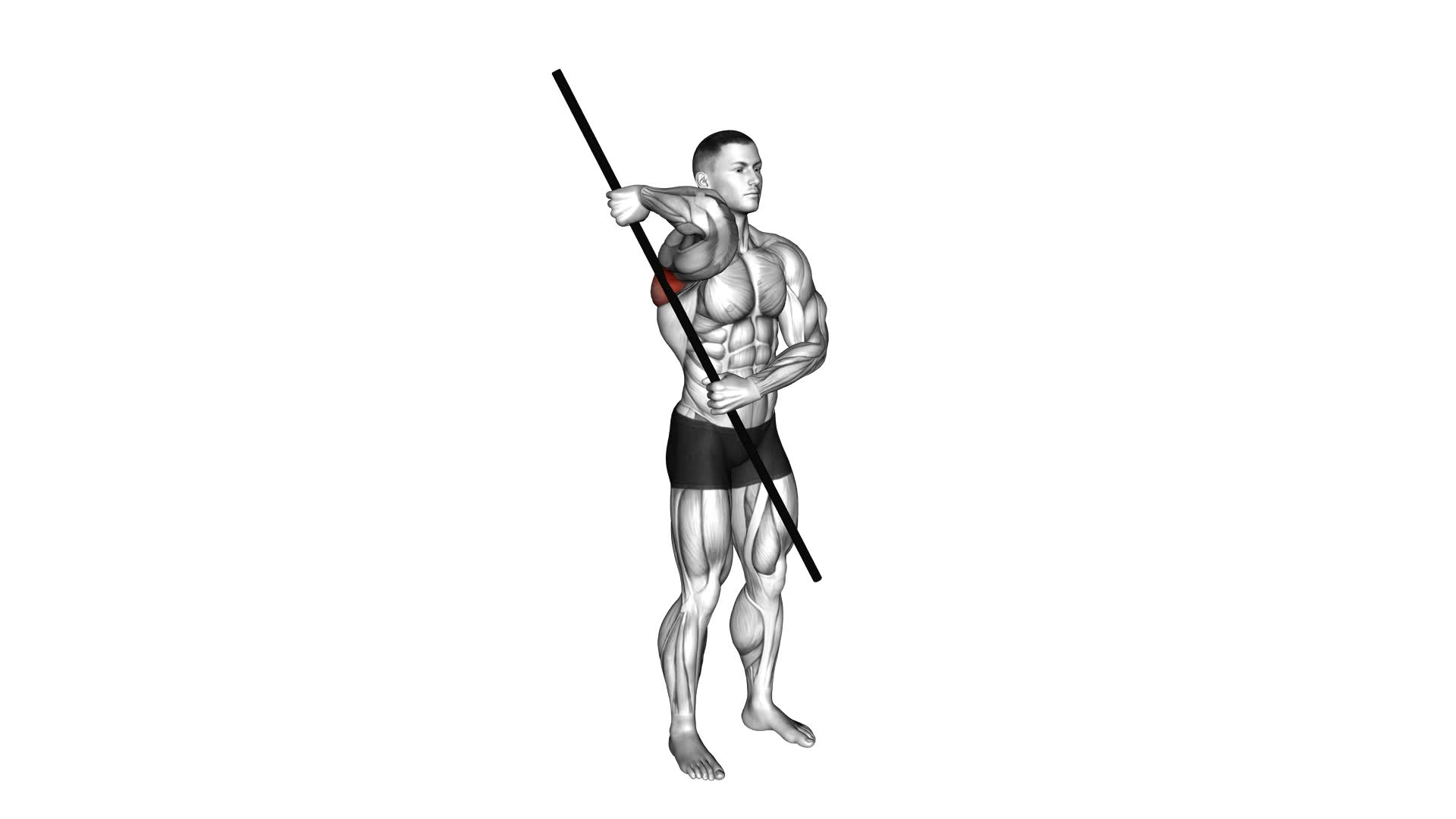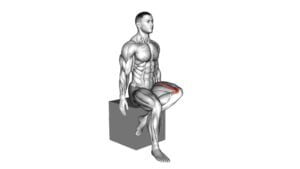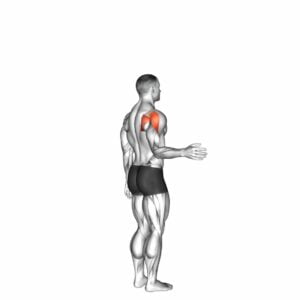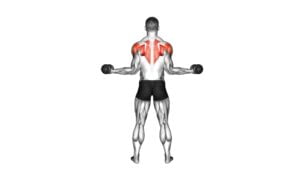PVC External Rotation – Video Exercise Guide & Tips

Looking to strengthen your shoulders and improve range of motion? Check out our video exercise guide and tips for PVC external rotation.
Watch This Exercise Video
This exercise targets the rotator cuff muscles and can be done with just a PVC pipe. Learn the proper form and technique, common mistakes to avoid, and variations for progression.
Maximize the effectiveness of your workouts with these expert tips. Let's get started!
Key Takeaways
- PVC External Rotation exercise is highly effective for injury prevention and shoulder mobility improvement.
- It strengthens and stabilizes the shoulder joint, reducing the risk of impingement or rotator cuff tears.
- The exercise enhances range of motion, stability, and strength in the shoulders and upper back.
- It is important to maintain proper form and technique, listen to your body, and avoid common mistakes like using excessive weight or compromising form.
Benefits of PVC External Rotation
You can experience several benefits from incorporating PVC external rotation exercises into your workout routine. These exercises are highly effective for injury prevention and improving shoulder mobility. By targeting the rotator cuff muscles, PVC external rotation exercises help to strengthen and stabilize the shoulder joint, reducing the risk of injuries such as shoulder impingement or rotator cuff tears.
Additionally, these exercises improve the range of motion in your shoulders, allowing for better movement and flexibility during your workouts.
One of the key benefits of PVC external rotation exercises is injury prevention. When performed correctly and consistently, these exercises help to strengthen the muscles surrounding the shoulder joint, providing stability and support. This can help to prevent common shoulder injuries that can occur due to overuse, improper form, or weak muscles. By incorporating these exercises into your routine, you can significantly reduce the risk of experiencing shoulder pain or discomfort.
Another benefit of PVC external rotation exercises is improved shoulder mobility. These exercises target the rotator cuff muscles, which are responsible for the rotational movements of the shoulder joint. By strengthening these muscles, you can improve your shoulder's range of motion, allowing for smoother and more fluid movements. This can be particularly beneficial for athletes or individuals who engage in activities that require a wide range of shoulder motion, such as throwing, swimming, or weightlifting.
In order to fully reap the benefits of PVC external rotation exercises, it's important to ensure proper form and technique.
Proper Form and Technique
To ensure proper form and technique, it's crucial to focus on maintaining a neutral spine throughout PVC external rotation exercises. This will help you avoid injuries and ensure effective muscle activation. Here are some key tips to keep in mind:
- Maintain a neutral spine: Keep your back straight and avoid arching or rounding your back during the exercise. This will help distribute the load evenly and protect your spine.
- Engage your core: Activate your core muscles by drawing your belly button towards your spine. This will provide stability and support throughout the movement.
- Control the movement: Slowly rotate your arms outward while keeping your elbows close to your body. Avoid swinging or jerking the PVC pipe, as this can strain your shoulders and lead to injuries.
- Focus on shoulder blades: Squeeze your shoulder blades together as you rotate your arms. This will help engage the muscles in your upper back and promote proper shoulder alignment.
- Listen to your body: Pay attention to any discomfort or pain during the exercise. If you experience any sharp or persistent pain, stop the exercise and consult a healthcare professional.
Common Mistakes to Avoid
To ensure proper form and technique during PVC external rotation exercises, it's important to be aware of common mistakes that should be avoided. By understanding and avoiding these mistakes, you can maximize the effectiveness of your workout and reduce the risk of injury.
One common mistake to avoid is using too much weight. While it may be tempting to use heavier PVC pipes to increase the intensity of the exercise, it can compromise your form and lead to muscle imbalances. It's crucial to start with a weight that allows you to maintain proper technique throughout the movement.
Another mistake to watch out for is allowing your shoulders to roll forward or hunching your back during the exercise. This can put unnecessary strain on your shoulders and decrease the effectiveness of the exercise. Focus on keeping your shoulders pulled back and down, and your chest lifted throughout the movement.
Additionally, rushing through the exercise is a common mistake that can compromise your form and limit the benefits of the exercise. Take your time and perform each repetition with control and precision. This will engage the targeted muscles more effectively and reduce the risk of injury.
Variations and Progressions
To further challenge yourself and continue progressing with PVC external rotation exercises, you can explore various variations and progressions. Here are some modifications you can try to take your workout to the next level:
- Increase resistance: Use a heavier PVC pipe or add weight plates to the ends of the pipe to increase the resistance and make the exercise more challenging.
- Single-arm external rotation: Perform the exercise with one arm at a time, focusing on maintaining proper form and control throughout the movement.
- Standing external rotation: Instead of sitting on a bench or chair, stand up and perform the external rotation exercise. This engages your core and stabilizer muscles to a greater extent.
- Dynamic external rotation: Instead of holding the end position, perform the exercise in a controlled and smooth motion, moving the PVC pipe from internal to external rotation and back again.
- Isometric holds: At the end of each external rotation, hold the position for a few seconds to increase muscle activation and strengthen the rotator cuff.
By incorporating these progressions and modifications into your PVC external rotation exercises, you can continue challenging your muscles and improving your strength and stability.
Now, let's move on to the next section to learn some tips for maximizing the effectiveness of these exercises.
Tips for Maximizing Effectiveness
To maximize the effectiveness of your PVC external rotation exercises, incorporate these tips into your workout routine.
First and foremost, pay attention to your breathing techniques. Proper breathing can help enhance the effectiveness of the exercise and improve muscle activation. As you perform the PVC external rotation, exhale during the concentric phase (when you rotate the PVC pipe away from your body) and inhale during the eccentric phase (when you bring the PVC pipe back towards your body). This controlled breathing pattern will help you maintain stability and control throughout the movement.
In addition to focusing on your breathing, it's crucial to warm up before performing PVC external rotation exercises. Warming up prepares your muscles, joints, and connective tissues for the upcoming exercise, reducing the risk of injury and maximizing the effectiveness of the workout. Incorporate dynamic warm-up exercises that target the muscles involved in external rotation, such as shoulder circles, arm swings, or band pull-aparts. These exercises will increase blood flow, improve range of motion, and activate the muscles, priming your body for the PVC external rotation exercise.
Frequently Asked Questions
Can PVC External Rotation Exercises Help With Shoulder Impingement?
PVC external rotation exercises can be effective in addressing shoulder impingement. These exercises specifically target the rotator cuff muscles, which are often affected by impingement. They help strengthen and stabilize the shoulder joint, reducing the risk of impingement.
While there are other shoulder rehabilitation techniques available, PVC external rotation exercises offer a simple and accessible option that can be easily incorporated into your routine.
It's always recommended to consult with a healthcare professional for a personalized treatment plan.
How Often Should I Perform PVC External Rotation Exercises?
To maximize the benefits of PVC external rotation exercises, it's important to consider frequency. How often should you perform these exercises?
Well, the frequency will depend on various factors such as your current fitness level and any underlying shoulder issues. It's recommended to start with a frequency of 2-3 times per week and gradually increase as tolerated.
Consistency is key to seeing improvements in shoulder strength and mobility.
Can PVC External Rotation Exercises Be Done With Resistance Bands Instead of PVC Pipes?
Resistance band alternatives can be used for PVC external rotation exercises. They offer several benefits, such as providing variable resistance and targeting specific muscle groups. Using resistance bands allows for a wider range of motion and can help improve flexibility and strength.
Additionally, they're portable and versatile, making them convenient for workouts at home or on the go. Incorporating resistance bands into your PVC external rotation routine can enhance your overall exercise experience.
Are PVC External Rotation Exercises Suitable for Individuals With a History of Shoulder Injuries?
If you have a history of shoulder injuries, it's important to consider your shoulder rehabilitation when deciding on exercises.
While PVC external rotation exercises can be beneficial for shoulder strengthening, it's essential to consult with a healthcare professional or physical therapist to ensure they're suitable for your specific condition.
They may recommend alternative exercises or modifications to protect your shoulder and prevent further injury.
Always prioritize your safety and follow expert guidance in your rehabilitation journey.
Can PVC External Rotation Exercises Help Improve Throwing Performance in Athletes?
PVC external rotation exercises are a valuable tool for overhead athletes looking to improve their throwing performance. By targeting the rotator cuff muscles, these exercises can enhance shoulder stability and increase range of motion, ultimately leading to better throwing mechanics and power.
The benefits of PVC external rotation exercises in sports performance can't be overstated. Incorporating these exercises into your training routine can help you maximize your athletic potential and reduce the risk of shoulder injuries.
Conclusion
In conclusion, incorporating PVC external rotation exercises into your workout routine can offer numerous benefits. These exercises can strengthen the rotator cuff muscles and improve shoulder stability.
By following proper form and technique, you can ensure that you are performing the exercise correctly. This will help you avoid common mistakes that can lead to injury or reduce the effectiveness of the exercise.
Additionally, exploring variations and progressions of PVC external rotations can help you continue challenging your muscles and making progress. This can involve increasing the weight or resistance, changing the angle or position of the exercise, or incorporating other equipment or movements.
Remember to consult a professional trainer or therapist for personalized guidance. They can assess your specific needs and goals, and provide you with expert advice on how to perform PVC external rotations safely and effectively.

Author
Years ago, the spark of my life’s passion ignited in my mind the moment I stepped into the local gym for the first time. The inaugural bead of perspiration, the initial endeavor, the very first surge of endorphins, and a sense of pride that washed over me post-workout marked the beginning of my deep-seated interest in strength sports, fitness, and sports nutrition. This very curiosity blossomed rapidly into a profound fascination, propelling me to earn a Master’s degree in Physical Education from the Academy of Physical Education in Krakow, followed by a Sports Manager diploma from the Jagiellonian University. My journey of growth led me to gain more specialized qualifications, such as being a certified personal trainer with a focus on sports dietetics, a lifeguard, and an instructor for wellness and corrective gymnastics. Theoretical knowledge paired seamlessly with practical experience, reinforcing my belief that the transformation of individuals under my guidance was also a reflection of my personal growth. This belief holds true even today. Each day, I strive to push the boundaries and explore new realms. These realms gently elevate me to greater heights. The unique combination of passion for my field and the continuous quest for growth fuels my drive to break new ground.







